The Analysis of the Extreme Cold in North America Linked to the Western Hemisphere Circulation Pattern
Abstract
1. Introduction
2. Data and Methods
2.1. Datas and Extremely Cold Events
2.2. The Temperature Advection Methods
2.3. The Cold Air Mass and Flux Methods
2.4. Diagnosis of Vertical Propagation of Planetary Waves
2.5. Self-Organizing Maps
2.6. Surface Energy Budget
3. Result
3.1. The Developments of WH and ECEs in North America
3.2. The Temperature Advection on the Surface and 850 hPa in ECEs
3.3. CAM Flux and NHC in ECEs
3.4. The Surface Energy Budget
4. SOM Result of ECEs at 500 hPa and Stratospheric Diagnosis
5. Summary and Discussion
Author Contributions
Funding
Institutional Review Board Statement
Informed Consent Statement
Data Availability Statement
Acknowledgments
Conflicts of Interest
References
- Forbes, G.S.; Thomson, D.W.; Anthes, R.A. Synoptic and Mesoscale Aspects of an Appalachian Ice Storm Associated with Cold-Air Damming. Mon. Weather Rev. 1987, 115, 564–591. [Google Scholar] [CrossRef]
- Boberg, F.; Lundstedt, H. Solar wind electric field modulation of the NAO: A correlation analysis in the lower atmosphere. Geophys. Res. Lett. 2003, 30, 1825. [Google Scholar] [CrossRef]
- Notaro, M.; Wang, W.-C.; Gong, W. Model and Observational Analysis of the Northeast U.S. Regional Climate and Its Relationship to the PNA and NAO Patterns during Early Winter. Mon. Weather Rev. 2006, 134, 3479–3505. [Google Scholar] [CrossRef]
- Swanson, K.L.; Tsonis, A.A.; Wang, G. On the Role of Atmospheric Teleconnections in Climate. J. Clim. 2008, 21, 2990–3001. [Google Scholar]
- Jung, T.; Vitart, F.; Ferranti, L.; Morcrette, J.-J. Origin and predictability of the extreme negative NAO winter of 2009/10. Geophys. Res. Lett. 2011, 38, L07701. [Google Scholar] [CrossRef]
- Black, R.; Barlow, M.; Gershunov, A.; Lee, Y.-Y.; Leung, R.; Gyakum, J.R.; Grotjahn, R.; Gutowski, W.J.; Lim, Y.-K.; Bosilovich, M.; et al. North American extreme temperature events and related large scale meteorological patterns: A review of statistical methods, dynamics, modeling, and trends. Clim. Dyn. 2015, 46, 1151–1184. [Google Scholar]
- Shen, X.; Liu, B.; Lu, X. Weak Cooling of Cold Extremes Versus Continued Warming of Hot Extremes in China During the Recent Global Surface Warming Hiatus. J. Geophys. Res. Atmos. 2018, 123, 4073–4087. [Google Scholar] [CrossRef]
- Lemus-Canovas, M. Changes in compound monthly precipitation and temperature extremes and their relationship with teleconnection patterns in the Mediterranean. J. Hydrol. 2022, 608, 127580. [Google Scholar] [CrossRef]
- Folland, C.K.; Knight, J.R.; Vallis, G.K.; Scaife, A.A. A stratospheric influence on the winter NAO and North Atlantic surface climate. Geophys. Res. Lett. 2005, 32, L18715. [Google Scholar] [CrossRef]
- Portis, D.H.; Walsh, J.E.; Rauber, R.M.; Cellitti, M.P. Extreme cold air outbreaks over the United States, the polar vortex, and the large-scale circulation. J. Geophys. Res. Atmos. 2006, 111, D02114. [Google Scholar] [CrossRef]
- Turner, J.K.; Gyakum, J.R. The Development of Arctic Air Masses in Northwest Canada and Their Behavior in a Warming Climate. J. Clim. 2011, 24, 4618–4633. [Google Scholar] [CrossRef]
- Hitchcock, P.; Simpson, I.R. The Downward Influence of Stratospheric Sudden Warmings. J. Atmos. Sci. 2014, 71, 3856–3876. [Google Scholar] [CrossRef]
- Baldwin, M.P.; Scaife, A.A.; Hardiman, S.C.; Kidston, J.; Butchart, N.; Mitchell, D.M.; Gray, L.J. Stratospheric influence on tropospheric jet streams, storm tracks and surface weather. Nat. Geosci. 2015, 8, 433–440. [Google Scholar]
- Thompson, D.W.J.; Wallace, J.M. The Arctic oscillation signature in the wintertime geopotential height and temperature fields. Geophys. Res. Lett. 1998, 25, 1297–1300. [Google Scholar] [CrossRef]
- Foster, J.; Barlow, M.; Saito, K.; Cohen, J.; Jones, J. Winter 2009–2010: A case study of an extreme Arctic Oscillation event. Geophys. Res. Lett. 2010, 37, L17707. [Google Scholar] [CrossRef]
- Baxter, S.; Nigam, S. Key Role of the North Pacific Oscillation–West Pacific Pattern in Generating the Extreme 2013/14 North American Winter. J. Clim. 2015, 28, 8109–8117. [Google Scholar] [CrossRef]
- Van Oldenborgh, G.J.; Haarsma, R.; De Vries, H.; Allen, M.R. Cold Extremes in North America vs. Mild Weather in Europe: The Winter of 2013–14 in the Context of a Warming World. Bull. Am. Meteorol. Soc. 2015, 96, 707–714. [Google Scholar] [CrossRef]
- Hartmann, D.L.; Ceppi, P.; Bao, M.; Tan, X. The Role of Synoptic Waves in the Formation and Maintenance of the Western Hemisphere Circulation Pattern. J. Clim. 2017, 30, 10259–10274. [Google Scholar]
- Bao, M.; Wallace, J.M. Cluster Analysis of Northern Hemisphere Wintertime 500-hPa Flow Regimes during 1920–2014. J. Atmos. Sci. 2015, 72, 3597–3608. [Google Scholar] [CrossRef]
- Tan, X.; Bao, M. Linkage Between a Dominant Mode in the Lower Stratosphere and the Western Hemisphere Circulation Pattern. Geophys. Res. Lett. 2020, 47, e2020GL090105. [Google Scholar] [CrossRef]
- Kanamitsu, M.; Ebisuzaki, W.; Woollen, J.; Yang, S.-K.; Hnilo, J.J.; Fiorino, M.; Potter, G.L. NCEP–DOE AMIP-II Reanalysis (R-2). Bull. Am. Meteorol. Soc. 2002, 83, 1631–1644. [Google Scholar] [CrossRef]
- Quiroz, R.S. The Climate of the 1983–84 Winter—A Season of Strong Blocking and Severe Cold in North America. Mon. Weather Rev. 1984, 112, 1894–1912. [Google Scholar] [CrossRef]
- Clark, J.P.; Feldstein, S.B. What Drives the North Atlantic Oscillation’s Temperature Anomaly Pattern? Part I: The Growth and Decay of the Surface Air Temperature Anomalies. J. Atmos. Sci. 2020, 77, 185–198. [Google Scholar] [CrossRef]
- Iwasaki, T.; Mochizuki, Y. Mass-Weighted Isentropic Zonal Mean Equatorward Flow in the Northern Hemispheric Winter. Sola 2012, 8, 115–118. [Google Scholar] [CrossRef]
- Takaya, K.; Sawada, M.; Ujiie, M.; Shoji, T.; Iwasaki, T.; Kanno, Y. Isentropic Analysis of Polar Cold Airmass Streams in the Northern Hemispheric Winter. J. Atmos. Sci. 2014, 71, 2230–2243. [Google Scholar]
- Iida, M.; Sugimoto, S.; Suga, T. Severe Cold Winter in North America Linked to Bering Sea Ice Loss. J. Clim. 2020, 33, 8069–8085. [Google Scholar] [CrossRef]
- Abdillah, M.R.; Kanno, Y.; Iwasaki, T. Tropical–Extratropical Interactions Associated with East Asian Cold Air Outbreaks. Part I: Interannual Variability. J. Clim. 2017, 30, 2989–3007. [Google Scholar] [CrossRef]
- Nishii, K.; Nakamura, H.; Orsolini, Y.J. Geographical Dependence Observed in Blocking High Influence on the Stratospheric Variability through Enhancement and Suppression of Upward Planetary-Wave Propagation. J. Clim. 2011, 24, 6408–6423. [Google Scholar] [CrossRef]
- Ueda, M.; Mukougawa, H.; Maury, P.; Claud, C.; Kodera, K. Absorbing and reflecting sudden stratospheric warming events and their relationship with tropospheric circulation. J. Geophys. Res. Atmos. 2016, 121, 80–94. [Google Scholar]
- Hewitson, B.C.; Crane, R.G. Consensus between GCM climate change projections with empirical downscaling: Precipitation downscaling over South Africa. Int. J. Climatol. 2006, 26, 1315–1337. [Google Scholar] [CrossRef]
- Arritt, R.W.; Gutowski, W.J.; Otieno, F.O.; Pan, Z.; Takle, E.S. Diagnosis and Attribution of a Seasonal Precipitation Deficit in a U.S. Regional Climate Simulation. J. Hydrometeorol. 2004, 5, 230–242. [Google Scholar]
- Cassano, E.N.; Uotila, P.; Cassano, J.J.; Lynch, A.H. Predicted changes in synoptic forcing of net precipitation in large Arctic river basins during the 21st century. J. Geophys. Res. Biogeosci. 2007, 112, G04S49. [Google Scholar] [CrossRef]
- Gong, T.; Feldstein, S.; Lee, S. The Role of Downward Infrared Radiation in the Recent Arctic Winter Warming Trend. J. Clim. 2017, 30, 4937–4949. [Google Scholar] [CrossRef]
- Gong, T.; Screen, J.A.; Simmonds, I.; Lee, S.; Feldstein, S.B. Revisiting the Cause of the 1989–2009 Arctic Surface Warming Using the Surface Energy Budget: Downward Infrared Radiation Dominates the Surface Fluxes. Geophys. Res. Lett. 2017, 44, 10654–10661. [Google Scholar] [CrossRef]
- Marinaro, A.; Hilberg, S.; Changnon, D.; Angel, J.R. The North Pacific–Driven Severe Midwest Winter of 2013/14. J. Appl. Meteorol. Climatol. 2015, 54, 2141–2151. [Google Scholar] [CrossRef]
- Zhong, L.; Luo, B.; Luo, D.; Wu, L.; Simmonds, I. Atmospheric circulation patterns which promote winter Arctic sea ice decline. Environ. Res. Lett. 2017, 12, 054017. [Google Scholar] [CrossRef]
- Thompson, D.W.J.; Baldwin, M.P.; Wallace, J.M. Stratospheric Connection to Northern Hemisphere Wintertime Weather: Implications for Prediction. J. Clim. 2002, 15, 1421–1428. [Google Scholar] [CrossRef]
- Kolstad, E.W.; Breiteig, T.; Scaife, A.A. The association between stratospheric weak polar vortex events and cold air outbreaks in the Northern Hemisphere. Q. J. R. Meteorol. Soc. 2010, 136, 886–893. [Google Scholar] [CrossRef]
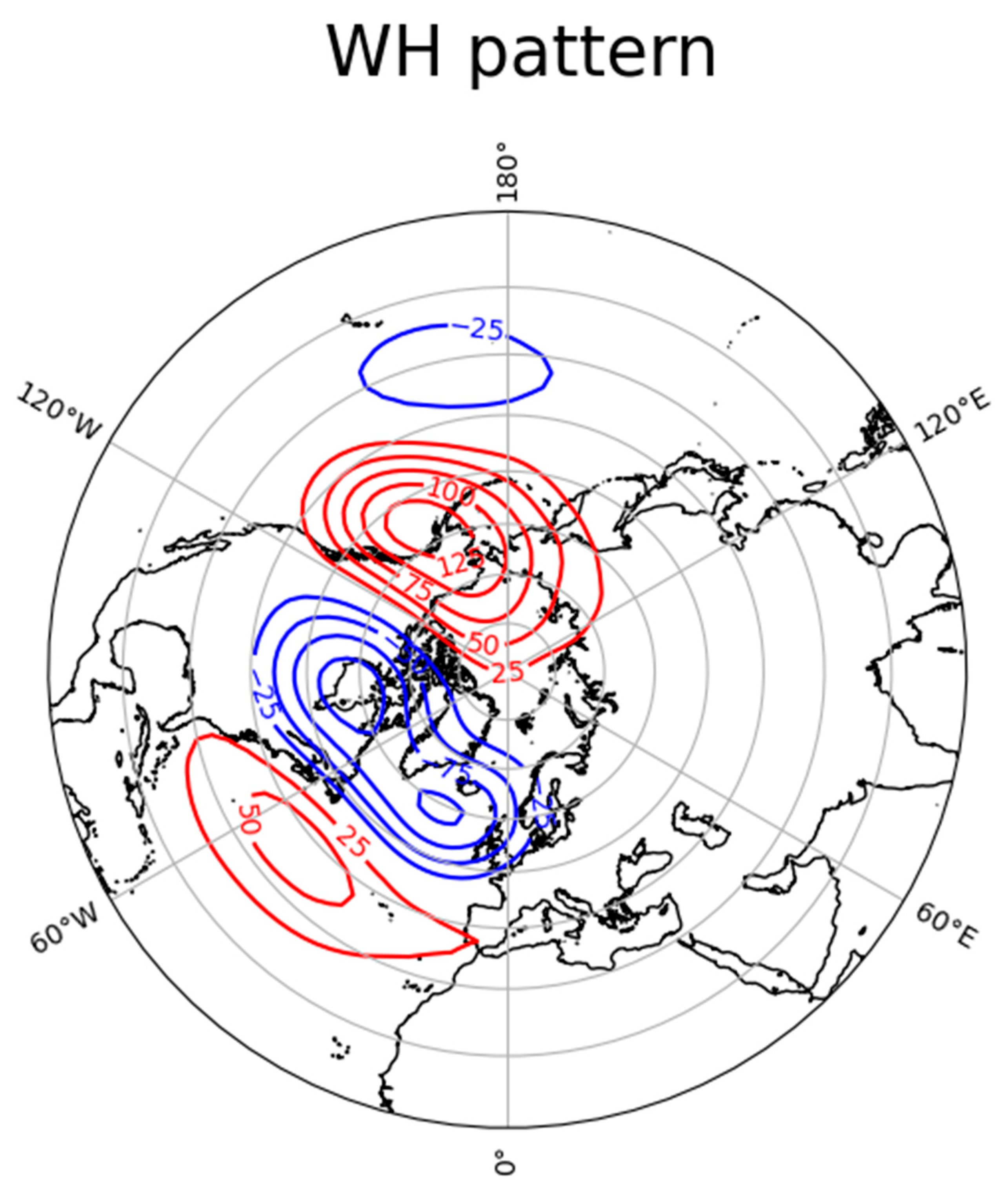
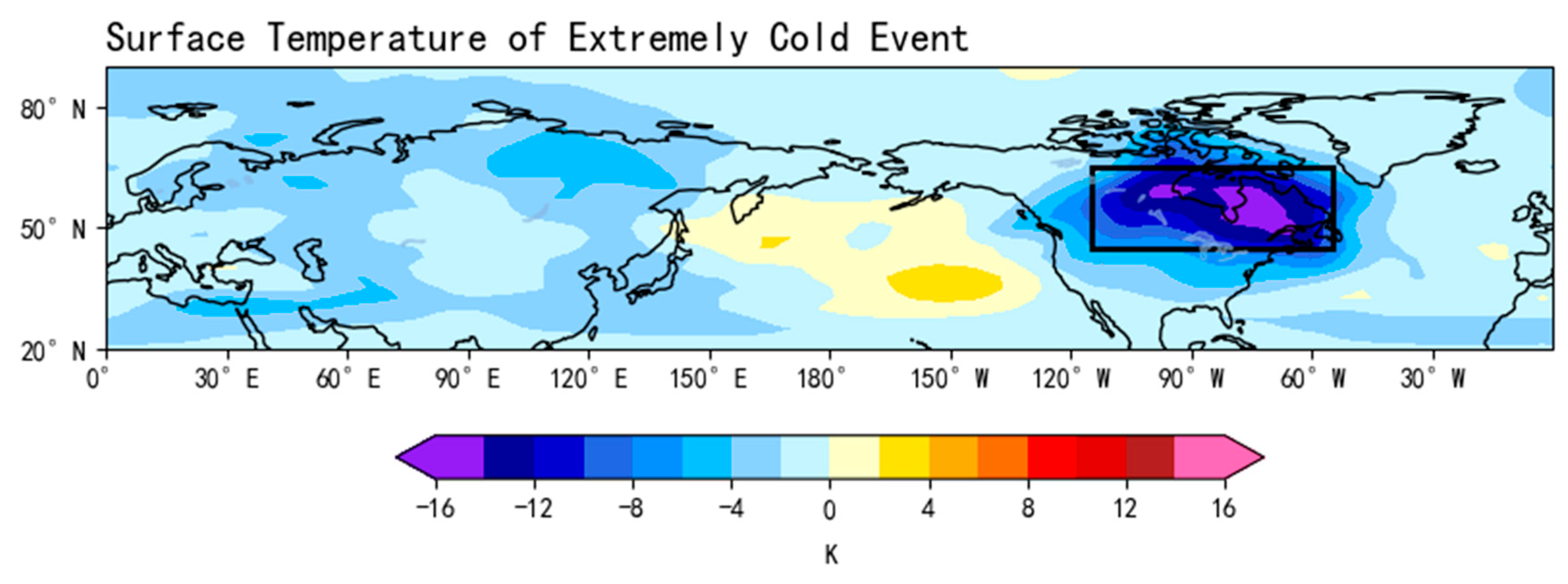


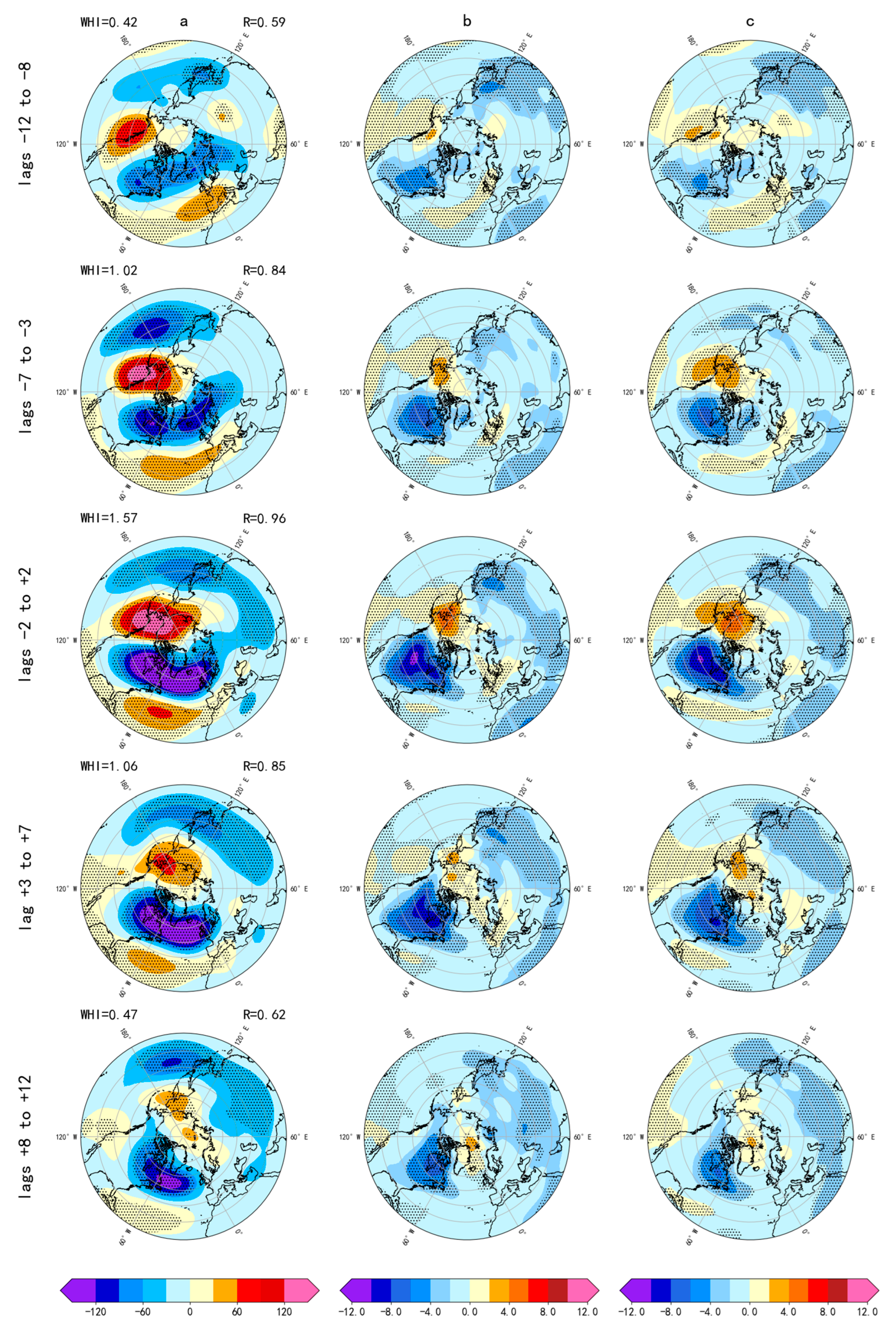
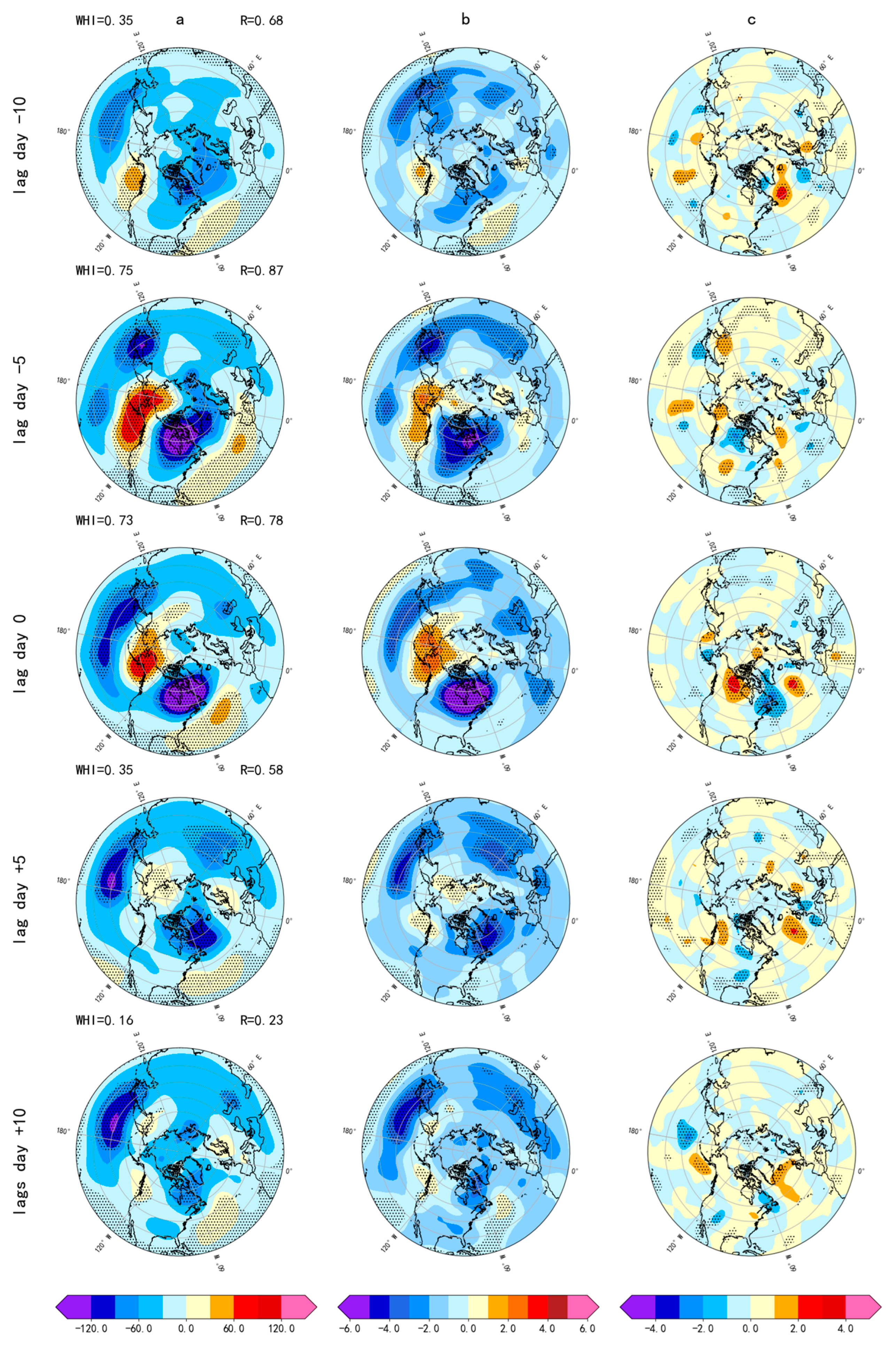

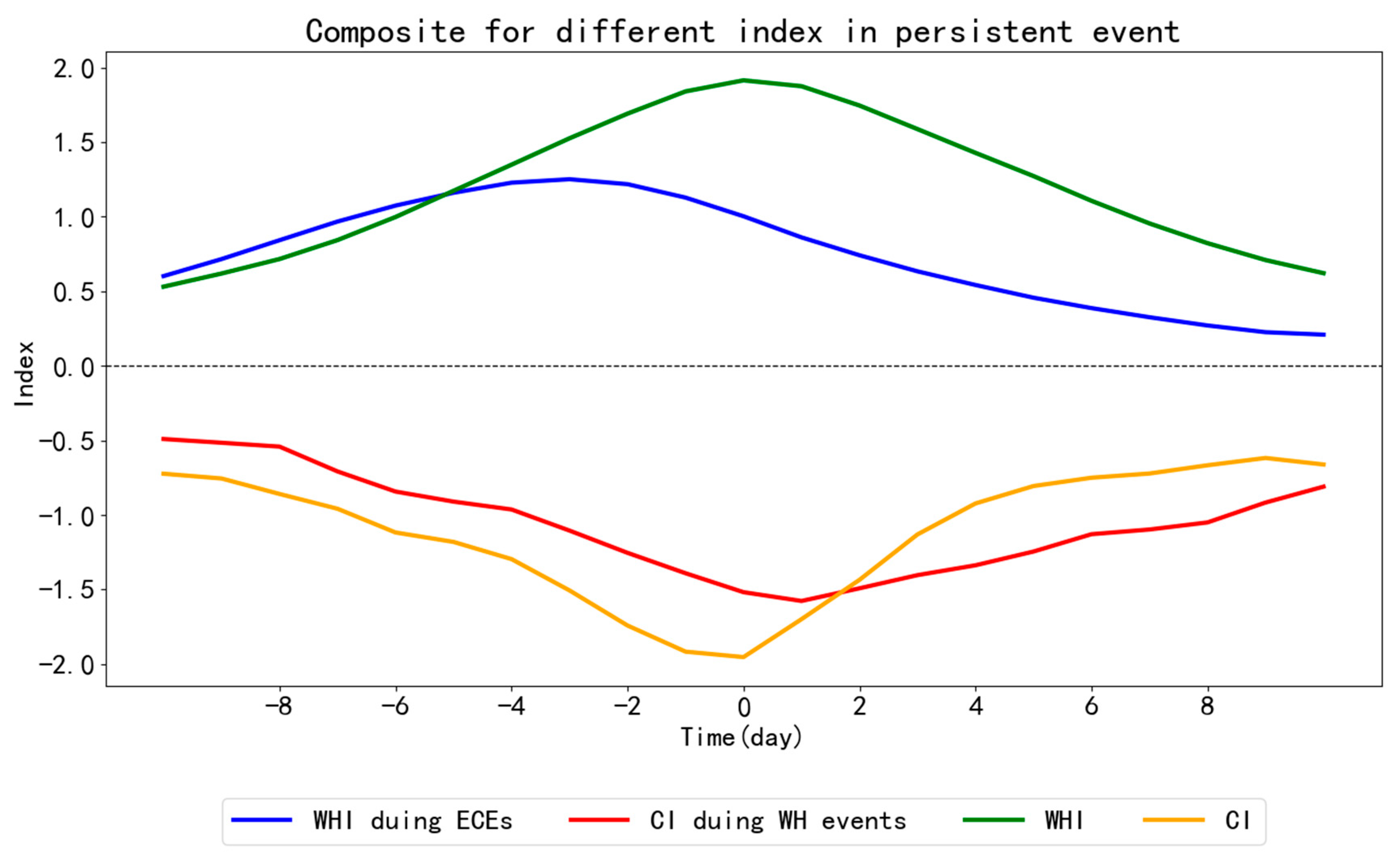
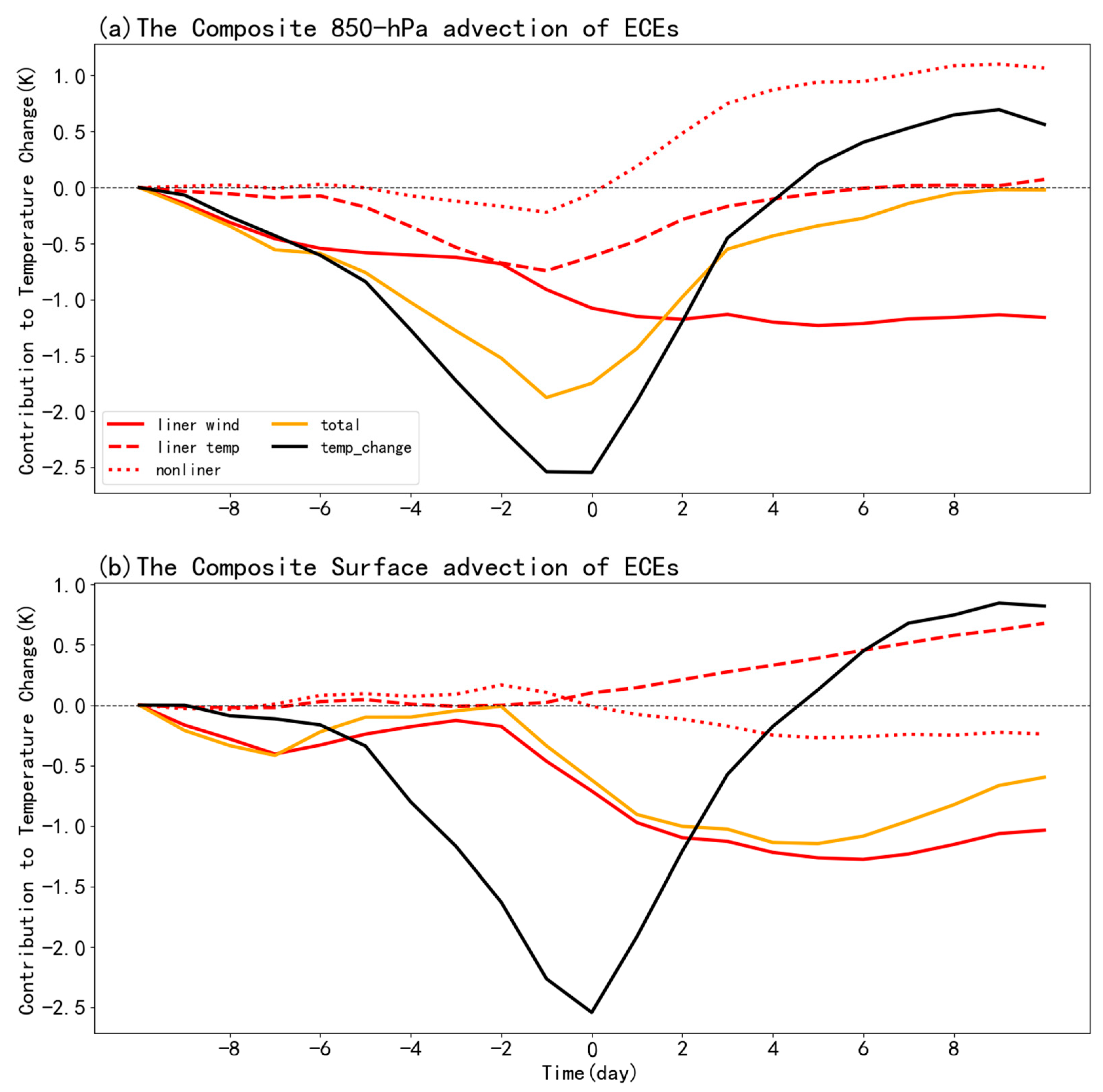
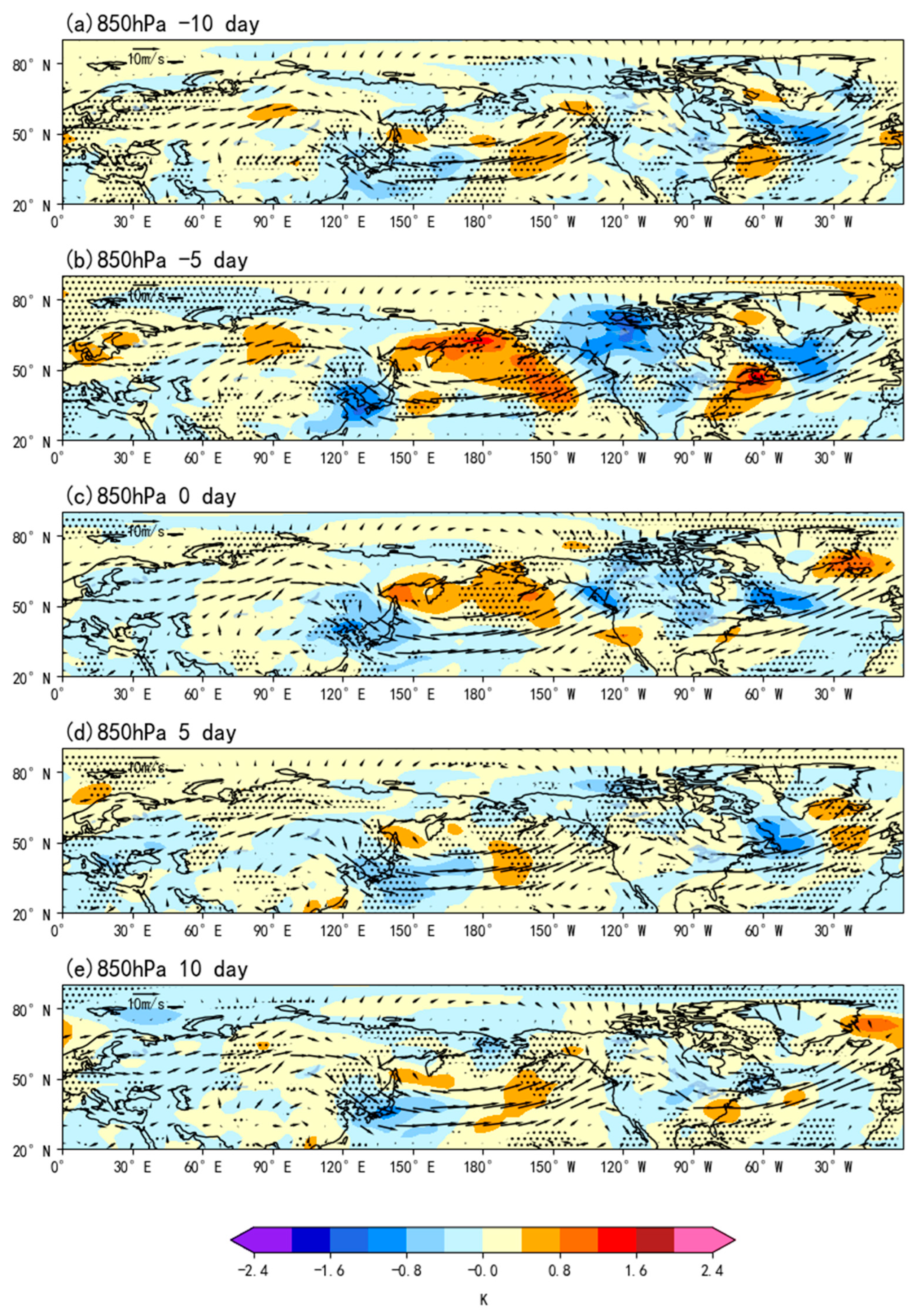
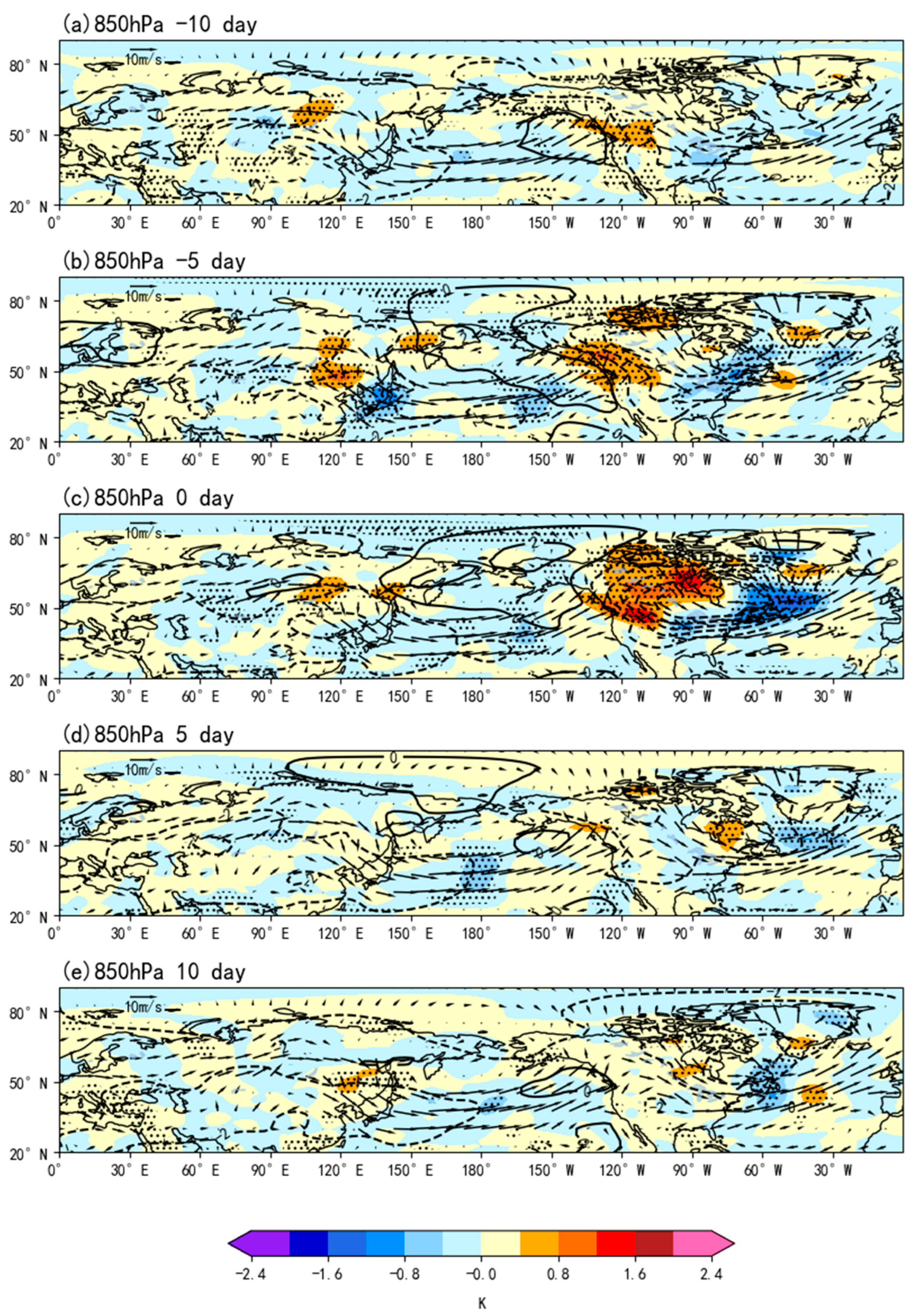
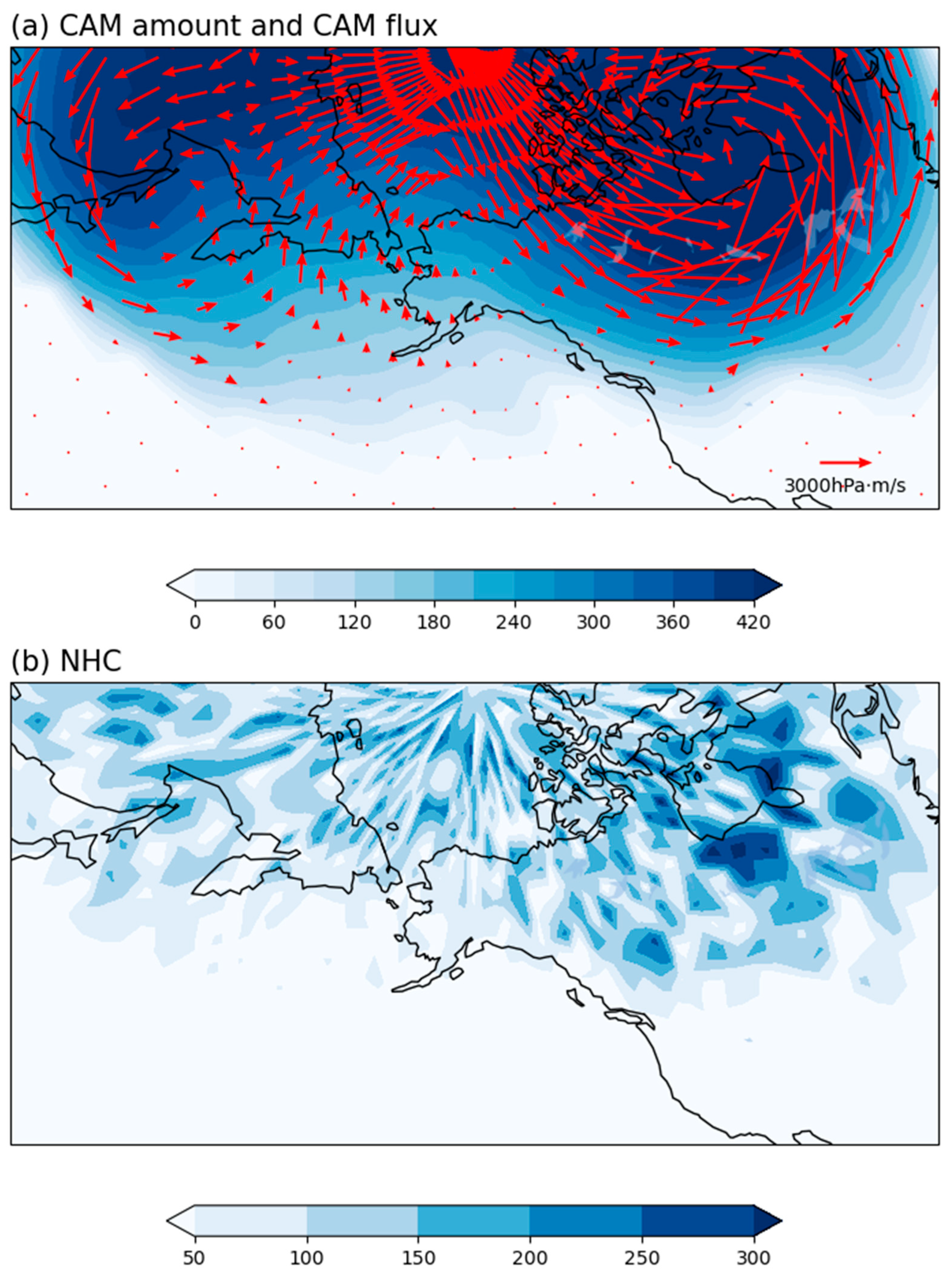

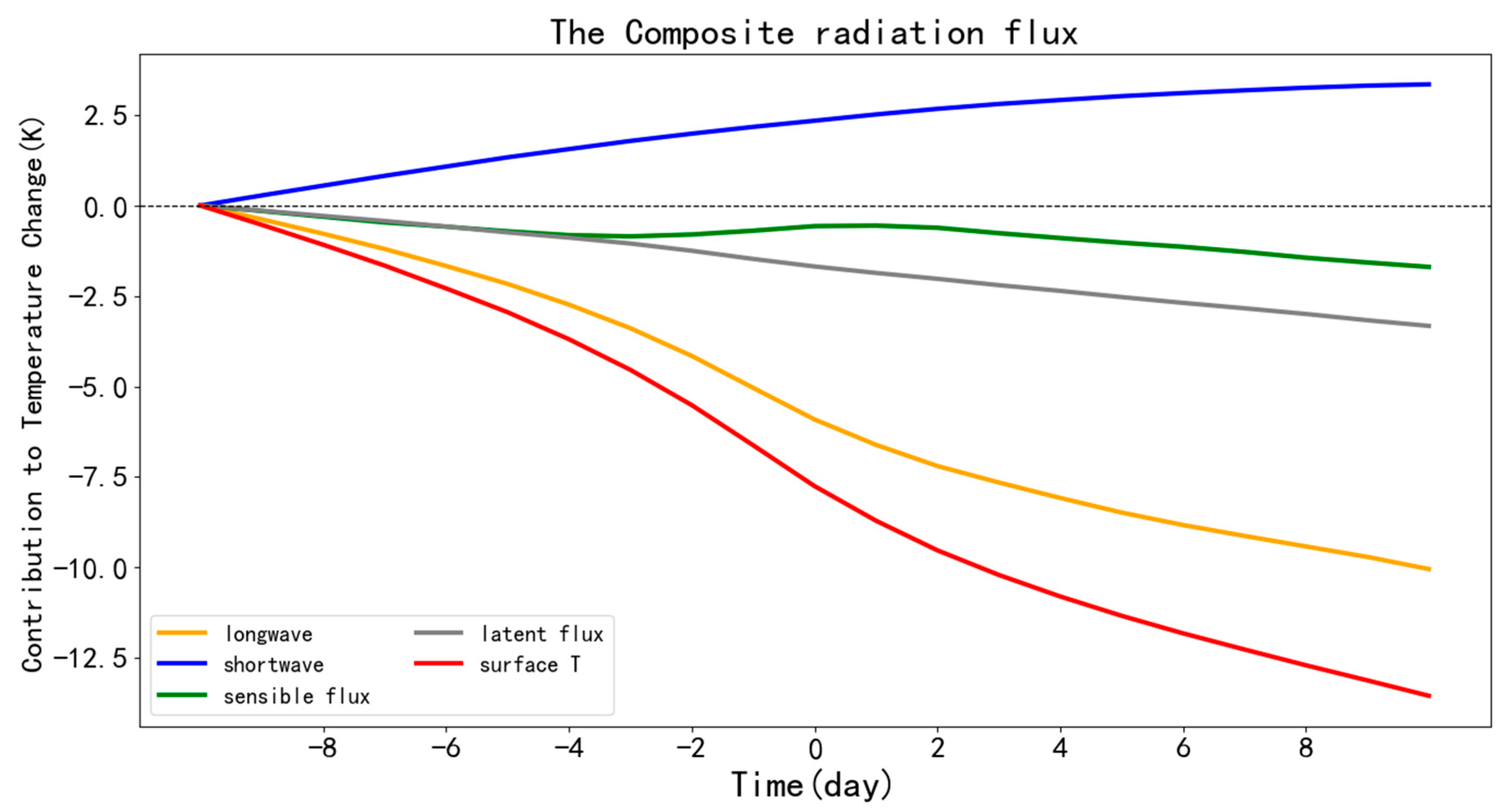

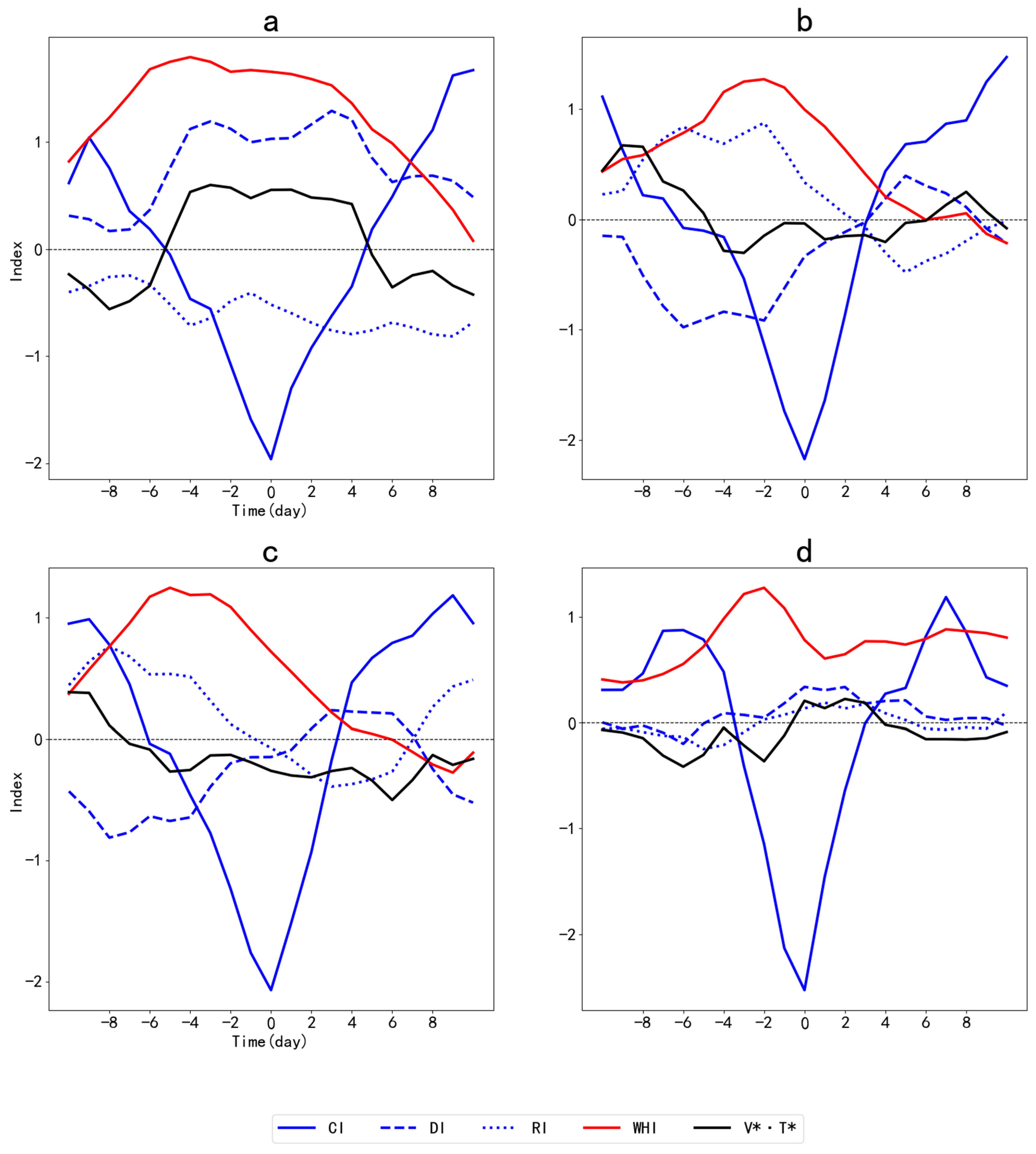
Disclaimer/Publisher’s Note: The statements, opinions and data contained in all publications are solely those of the individual author(s) and contributor(s) and not of MDPI and/or the editor(s). MDPI and/or the editor(s) disclaim responsibility for any injury to people or property resulting from any ideas, methods, instructions or products referred to in the content. |
© 2025 by the authors. Licensee MDPI, Basel, Switzerland. This article is an open access article distributed under the terms and conditions of the Creative Commons Attribution (CC BY) license (https://creativecommons.org/licenses/by/4.0/).
Share and Cite
Shen, M.; Tan, X. The Analysis of the Extreme Cold in North America Linked to the Western Hemisphere Circulation Pattern. Atmosphere 2025, 16, 781. https://doi.org/10.3390/atmos16070781
Shen M, Tan X. The Analysis of the Extreme Cold in North America Linked to the Western Hemisphere Circulation Pattern. Atmosphere. 2025; 16(7):781. https://doi.org/10.3390/atmos16070781
Chicago/Turabian StyleShen, Mohan, and Xin Tan. 2025. "The Analysis of the Extreme Cold in North America Linked to the Western Hemisphere Circulation Pattern" Atmosphere 16, no. 7: 781. https://doi.org/10.3390/atmos16070781
APA StyleShen, M., & Tan, X. (2025). The Analysis of the Extreme Cold in North America Linked to the Western Hemisphere Circulation Pattern. Atmosphere, 16(7), 781. https://doi.org/10.3390/atmos16070781



